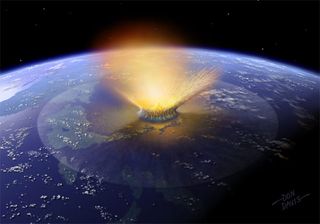
SAN FRANCISCO ? If a big asteroid were streaking toward Earth and time were running out, a well-placed nuclear explosion could help humanity avert catastrophe ? and not just in the movies.
A new study has injected new life into the old idea of dealing with a potentially threatening space rock by nuking it. The new analysis suggests that a nuclear blast could safely destroy even a relatively large asteroid. And astronauts wouldn't need to bore deep into the space rock, ? la Bruce Willis and his crew in the movie "Armageddon," to implant the bomb. An explosion on the asteroid's surface would likely do the trick, scientists report.
"It would be blown to smithereens," said study lead author Bob Weaver of Los Alamos National Laboratory in New Mexico, who presented the findings here Dec. 13 at the fall meeting of the American Geophysical Union.
Modeling an asteroid blast
People have talked for decades about the possibility of using a nuclear device to blow apart a potentially dangerous asteroid. But these discussions typically didn?t progress much beyond numerical arm-waving, Weaver said.
"There was a lot of back-of-the-envelope stuff," he told SPACE.com.
By contrast, Weaver said, he and his colleagues developed sophisticated codes to model exactly what would happen in such an explosion.
Get the Space.com Newsletter
Breaking space news, the latest updates on rocket launches, skywatching events and more!
In previous studies, the researchers had modeled how a nuke would affect a solid asteroid about 1,650 feet (500 meters) long and with a shape based on a known oblong space rock called Itokawa.
That work found that a nuke could blast the asteroid into pieces too small to pose much danger. And the explosion would send these pieces flying apart at tremendous speeds ? fast enough that they would not re-aggregrate to threaten the Earth again.
"That was extremely encouraging," Weaver said.
Updating the models
However, the team's older models assumed a solid chunk of rock ? no longer a very realistic expectation.
"We know asteroids are porous," Weaver said. "Many of them are basically rubble piles."
So, in the new study, the researchers modified their codes. The size of the asteroid remained the same, at 1,650 feet long, but now the researchers stipulated that it was 25 percent porous. It was attacked with a 500-kiloton nuclear blast ? about 20 to 30 times more powerful than the U.S. blast inflicted on Nagasaki, Japan, to help end World War II. [Top 10 Weapons in History]
The researchers exploded the nuke on the space rock's surface, as in previous models. And once again, the asteroid was blown to tiny, harmless bits that spread outward too quickly to be drawn back together.
The best results were achieved by positioning the explosive on the asteroid's short side, Weaver said, but any orientation they tried did the job.
"These calculations show that, even with a very porous object, a nuclear explosion can probably mitigate a potentially hazardous object," Weaver said.
Social and political obstacles
Weaver envisions humanity using a nuke in this fashion when there's not much time before impact ? a year or less, perhaps. (With more warning, other options could be on the table ? such as using an explosion to nudge the space rock out of the way of Earth.)
Humanity probably has the technological capability to pull off an asteroid-destroying mission right now, Weaver said. The tougher obstacle might be getting the international community to cooperate enough to organize such a strike. With nukes involved, working together might be difficult, he said.
"The social and political implications of how to carry out this mission are actually much tougher than the science," Weaver said.
While some people may find the prospect of using nuclear bombs unpalatable even to blast apart asteroids, conventional explosives just couldn't deliver, Weaver said ? at least not for a space rock as big as the one in the team's models.
"They're not even close," he said of conventional bombs. "They're orders of magnitude away from being powerful enough."
Anyway, it would be nice to have the nuclear option, according to Weaver, because the future is uncertain. In the past, massive impacts have wreaked havoc upon the Earth. A strike 65 million years ago, for example, is thought to have finished off the dinosaurs and many other species.
"This is something we'd like to have in our back pocket, just in case we need it," Weaver said.
- Images - Asteroids Up Close, Astronauts on Asteroids
- NASA's New Asteroid Mission Could Save the Planet
- Will an Asteroid Hit Earth? Are We All Doomed?
Join our Space Forums to keep talking space on the latest missions, night sky and more! And if you have a news tip, correction or comment, let us know at: community@space.com.

Michael Wall is a Senior Space Writer with Space.com and joined the team in 2010. He primarily covers exoplanets, spaceflight and military space, but has been known to dabble in the space art beat. His book about the search for alien life, "Out There," was published on Nov. 13, 2018. Before becoming a science writer, Michael worked as a herpetologist and wildlife biologist. He has a Ph.D. in evolutionary biology from the University of Sydney, Australia, a bachelor's degree from the University of Arizona, and a graduate certificate in science writing from the University of California, Santa Cruz. To find out what his latest project is, you can follow Michael on Twitter.
